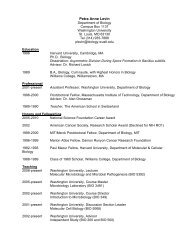Guide for doing FRAP with Leica TCS SP2 - Biocenter
Guide for doing FRAP with Leica TCS SP2 - Biocenter
Guide for doing FRAP with Leica TCS SP2 - Biocenter
You also want an ePaper? Increase the reach of your titles
YUMPU automatically turns print PDFs into web optimized ePapers that Google loves.
<strong>FRAP</strong>3. Identify a cell of interest and focus.Note: It can be helpful to use a fluorescent dye tocounter stain <strong>for</strong> the subcellular compartment understudy (s.a. DAPI (4',6-Diamidino-2-phenylindole) <strong>for</strong>the nucleus). With transiently transfected cells, alsocheck that the cell is not overexpressing ypi as thiswill interfere <strong>with</strong> data analysis. Overexpressioncan disturb the endogenous protein distribution.Furthermore, this may also make it harder to definethe subcellular compartment under study.4. Adjust laser intensity, detector gain, pinhole, <strong>for</strong>matand scan speed, as well as line averaging or bidirectionalscanning if appropriate. For freely diffusing(i.e. non-binding) molecules the fastest scanspeed setting and a small image <strong>for</strong>mat e.g.256x256 pixels should be used. Save settings <strong>for</strong>reproducibility.Note: Make sure to set the intensity below saturationand slightly above zero as this can interfere <strong>with</strong> dataanalysis. An appropriate lookup table (glow over/under) can help. Make sure to use the same gainsettings <strong>for</strong> all cells in a given series.Initial experimentsFor a new protein one has to decide which laser linesto use <strong>for</strong> the bleaching, which bleaching intensityand length of the bleach pulse is necessary. Furthermore,depending on the size and environment of ypi,the recovery can be very rapid. Also the number ofpost-bleach images has to be optimized in order toacquire enough in<strong>for</strong>mation <strong>for</strong> analysis and to avoidphotobleaching during post-bleach acquisition bytaking too many images.5. Now you can start the <strong>FRAP</strong> application. Doublecheckor reload the imaging settings determinedbe<strong>for</strong>e. To start <strong>with</strong>, using the FlyMode is a goodidea, because it will help to find the optimum length<strong>for</strong> the bleach pulse. With FlyMode you may reducethe time resolution down to 0.35 msec since the readoutof recovery is done between lines. This means,your recovery readout is closest possible to thereal zero time (t 0 ) of the postbleach intensity.The FlyMode combines both, the bleach scan andfirst image scan after bleaching. Bleaching is per<strong>for</strong>medduring fly <strong>for</strong>ward using ROI Scan features andhigh laser power. During fly back, the laser intensityis set to imaging values (AOTF switching <strong>with</strong>inmicro-seconds). Thus, the first image is acquiredsimultaneously <strong>with</strong> the bleaching frame. And consequently,the delay time between bleaching anddata acquisition is half the time needed to scan asingle line.Take 10 – 20 prebleach images. They determine theinitial intensity and will be important <strong>for</strong> normalizationof the data series later on. For EGFP a bleachpulse between 500 – 1000 ms <strong>with</strong> maximum laserpower often will be enough (unpublished result).This time frame may be obtained by adequate choiceof bleach iterations (i.e. if your recording interval is300 ms, setting the number of bleach iterations to 3will result in a 900 ms bleach pulse).The most importantin<strong>for</strong>mation about the fluorescence recoveryis contained <strong>with</strong>in the data immediately afterthe bleach pulse. There<strong>for</strong>e the first post-bleachstep (Fig. 1) should be recorded at the highest possiblerate. For proteins which interact <strong>with</strong> otherstructures or are membrane-bound the recoveryprocess can take several minutes or even more, sofurther post-bleach steps at slower frame rates maybe necessary. Initially, to set Post 2 to 60 images at 2 sintervals and Post 3 to 30 images at 10 s intervals willcover more than 6 minutes and will be long enough<strong>for</strong> most diffusion processes.Note: The frame rate can be maximized by using thehighest scan speed, small image <strong>for</strong>mats and bidirectionalscanning. Acquisition speed is proportionalto the number of lines scanned (y-<strong>for</strong>mat). The smallerthe number of pixels in x (x-<strong>for</strong>mat) the brighter theimage will be.Confocal Application Letter 3











